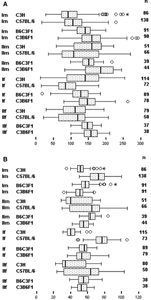Genotype-specific environmental impact on the variance of blood values in inbred and F1 hybrid mice (original) (raw)
Abstract
Mice are important models for biomedical research because of the possibility of standardizing genetic background and environmental conditions, which both affect phenotypic variability. Inbred mouse strains as well as F1 hybrid mice are routinely used as genetically defined animal models; however, only a few studies investigated the variance of phenotypic parameters in inbred versus F1 hybrid mice and the potential interference of the genetic background with different housing conditions. Thus, we analyzed the ranges of clinical chemical and hematologic parameters in C3H and C57BL/6 inbred mice and their reciprocal F1 hybrids (B6C3F1, C3B6F1) in two different mouse facilities. Two thirds of the blood parameters examined in the same strain differed between the facilities for both the inbred strains and the F1 hybrid lines. The relation of the values between inbred and F1 hybrid mice was also affected by the facility. The variance of blood parameters in F1 hybrid mice compared with their parental inbred strains was inconsistent in one facility but generally smaller in the other facility. A subsequent study of F1 hybrid animals derived from the parental strains C3H and BALB/c, which was done in the latter housing unit, detected no general difference in the variance of blood parameters between F1 hybrid and inbred mice. Our study clearly demonstrates the possibility of major interactions between genotype and environment regarding the variance of clinical chemical and hematologic parameters.
Access this article
Subscribe and save
- Get 10 units per month
- Download Article/Chapter or eBook
- 1 Unit = 1 Article or 1 Chapter
- Cancel anytime Subscribe now
Buy Now
Price excludes VAT (USA)
Tax calculation will be finalised during checkout.
Instant access to the full article PDF.
Fig. 1

Similar content being viewed by others
Explore related subjects
Discover the latest articles and news from researchers in related subjects, suggested using machine learning.
References
- Brown SD, Balling R (2001) Systematic approaches to mouse mutagenesis. Curr Opin Genet Dev 11: 268–273
Article CAS PubMed Google Scholar - Champy MF, Selloum M, Piard L, Zeitler V, Caradec C, et al. (2004) Mouse functional genomics requires standardization of mouse handling and housing conditions. Mamm Genome 15: 768–783
Article PubMed Google Scholar - Greiling H, Gressner AM (1995) Lehrbuch der Klinischen Chemie und Pathobiochemie (Stuttgart: Schattauer)
- Hough TA, Nolan PM, Tsipouri V, Toye AA, Gray IC, et al. (2002) Novel phenotypes identified by plasma biochemical screening in the mouse. Mamm Genome 13: 595–602
Article CAS PubMed Google Scholar - Hrabé de Angelis MH, Flaswinkel H, Fuchs H, Rathkolb B, Soewarto D, et al. (2000) Genome-wide, large-scale production of mutant mice by ENU mutagenesis. Nat Genet 25: 444–447
PubMed Google Scholar - Kile BT, Mason-Garrison CL, Justice MJ (2003) Sex and strain-related differences in the peripheral blood cell values of inbred mouse strains. Mamm Genome 14: 81–85
Article PubMed Google Scholar - Loeb WF, Quimby FW (1999) The clinical chemistry of laboratory animals (Philadelphia: Taylor & Francis)
- Olsson IA, Dahlborn K (2002) Improving housing conditions for laboratory mice: a review of “environmental enrichment.” Lab Anim 36: 243–270
Article CAS PubMed Google Scholar - Paigen K, Eppig JT (2000) A mouse phenome project. Mamm Genome 11: 715–17
Article CAS PubMed Google Scholar - Rathkolb B, Decker T, Fuchs E, Soewarto D, Fella C, et al. (2000a) The clinical-chemical screen in the Munich ENU Mouse Mutagenesis Project: screening for clinically relevant phenotypes. Mamm Genome 11: 543–546
Article CAS Google Scholar - Rathkolb B, Fuchs E, Kolb HJ, Renner-Muller I, Krebs O, et al. (2000b) Large-scale N-ethyl-N-nitrosourea mutagenesis of mice—from phenotypes to genes. Exp Physiol 85: 635–644
Article CAS Google Scholar - Russ A, Stumm G, Augustin M, Sedlmeier R, Wattler S, et al. (2002) Random mutagenesis in the mouse as a tool in drug discovery. Drug Discov Today 7: 1175–1183
Article CAS PubMed Google Scholar - Van Zutphen LFM, Baumans V, Beynen AC (2001) Principles of laboratory animal science (London: Elsevier)
Google Scholar
Acknowledgments
This work was supported by the German Human Genome Project (DHGP) (BR) and the National Genome Research Network (NGFN) (MK).
Author information
Authors and Affiliations
- Institute of Molecular Animal Breeding and Biotechnology, Ludwig-Maximilians-University, 81377, Munich, Germany
Martina Klempt, Birgit Rathkolb, Eckhard Wolf & Bernhard Aigner - Institute of Clinical Chemistry, Clinic Harlaching, 81545, Munich, Germany
Edith Fuchs - Institute of Experimental Genetics, GSF Research Center for Environment and Health, 85764, Neuherberg, Germany
Martin Hrabé de Angelis - Institut für Molekulare Tierzucht und Biotechnologie, Moorversuchsgut, Hackerstr. 27, D-85764, Oberschleißheim, Germany
Bernhard Aigner
Authors
- Martina Klempt
- Birgit Rathkolb
- Edith Fuchs
- Martin Hrabé de Angelis
- Eckhard Wolf
- Bernhard Aigner
Corresponding author
Correspondence toBernhard Aigner.
Rights and permissions
About this article
Cite this article
Klempt, M., Rathkolb, B., Fuchs, E. et al. Genotype-specific environmental impact on the variance of blood values in inbred and F1 hybrid mice.Mamm Genome 17, 93–102 (2006). https://doi.org/10.1007/s00335-005-0119-7
- Received: 02 September 2005
- Accepted: 12 October 2005
- Published: 07 February 2006
- Issue Date: February 2006
- DOI: https://doi.org/10.1007/s00335-005-0119-7